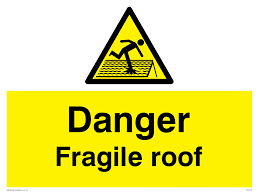Under the Work at Height Regulations 2005 there are specific requirements in relation to fragile surfaces, but what defines a fragile surface and how easy is it to determine whether or not a roof is fragile?
The Work at Height Regulations 2005 define a fragile surface as “a surface, which would be liable to fail if any reasonably foreseeable loading were to be applied to it”.
A person walking (with or without tools and/or materials) is a reasonable/foreseeable loading. Under the regulations, employers must ensure that no one working under their control (this includes contractors who may not be direct employees of the employer), goes onto or near a fragile surface unless that is the only reasonably practicable way for the worker to carry out the work safely — having regard to the demands of the task, equipment, or working environment.
A roof should always be treated as fragile until a competent person has agreed otherwise. Fragility may be caused by:
- general deterioration of the roof through ageing, neglect and lack of maintenance or weather damage
- corrosion of cladding and fixings
- the original materials being of poor quality or badly selected
- impact damage
- vandalism
- deterioration of the supporting structure.
Typical fragile materials include asbestos cement sheets, old roof lights, non-reinforced fibre cement sheets, corroded metal sheets, glass (including wired glass), slates and tiles.
Unless a roof is to be treated as fragile and the necessary precautions are taken in accordance with the Work at Height Regulations 2005, it will be necessary for a competent person to be employed to ascertain whether or not the roof is fragile.
For assessing fragility, a competent person can be defined as someone who can demonstrate that they have:
- a thorough knowledge of roofing and the mechanical and physical properties and behaviour of the particular product and assembly when subjected to the necessary test.
- extensive knowledge and experience of installation of the product, its usage limitations, behaviour and mode of failure in service.
It is important to note that a test will only give information on a product’s performance at the time of the test and that the roof’s properties may change over time due to the factors mentioned above.











